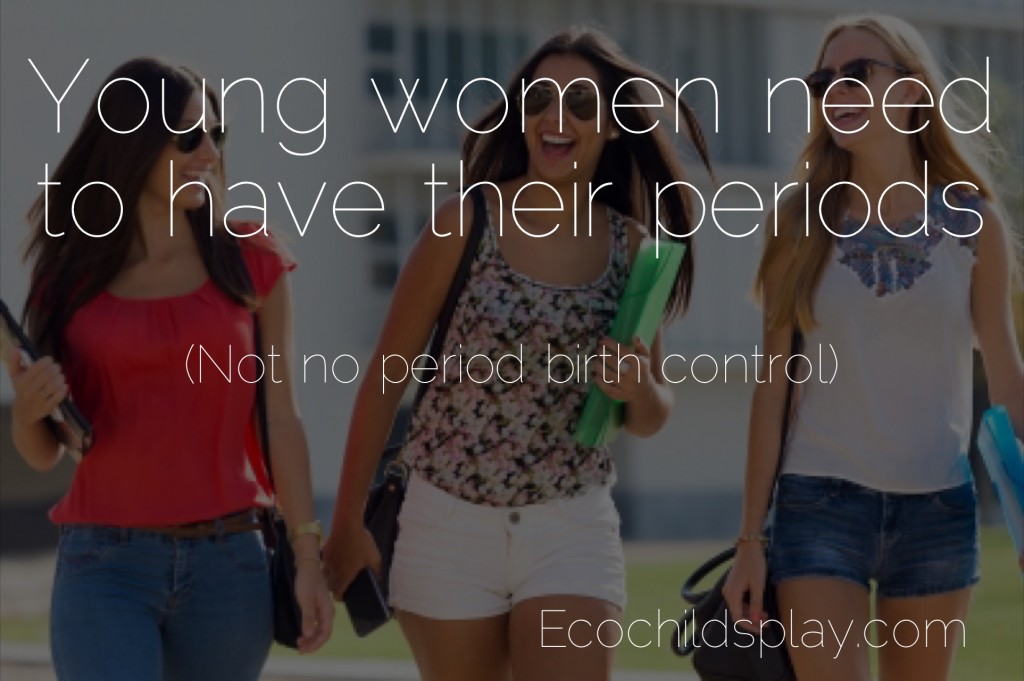
As our daughters enter into womanhood, first through menstruation then sexual activity, they are presented with many different options for both birth and period control.
WebMd explains all of the pharmaceutical birth control options available today:
- Lybrel is a no-period birth control pill. It is the first low dose birth control pill designed to be taken 365 days, without a placebo or pill-free interval.
- Seasonale has 12 weeks of estrogen/progestin pills, followed by 7 days of no-hormone pills — which means 4 menstrual periods a year.
- Seasonique has 12 weeks of estrogen/progestin pills, followed by 7 days of low-estrogen pills — which results in 4 light, short periods a year. It is similar to Seasonale but has 7 days of low-dose estrogen instead of placebo pills.
- Yaz is a less-PMS pill. It has a 28-pill monthly pack — 24 active pills and 4 inactive pills. Your monthly cycle is shorter, lighter, more regular. Beyaz is similar to Yaz but with a form of folic acid added to prevent birth defects should a woman become pregnant.
- Yasmin is a less-PMS, less-acne pill. It has 28-pill monthly packs — 21 active pills and 7 inactive pills. Your monthly period is lighter, more regular.((http://www.webmd.com/sex/birth-control/features/new-no-period-no-pms-birth-control-pills))
But what does pharmaceutically induced period suppression do to our young daughters?
Dr. Lara Briden, ND explains:
Ovulation is How Girls Make Hormones
Ovulation is not just about making a baby. It’s also the main hormonal event in a menstrual cycle, and the only way to make estrogen and progesterone. When we shut down ovulation with hormonal birth control, we rob girls of the hormones they need for metabolism, bone health, cardiovascular health, mood, and more.
Girls who take synthetic pseudo-hormones via the Pill lose the ability to produce their own hormones. Pseudo-hormones have some similarities to real human hormones, but they also have many differences. For example, the progestin levonorgestrel causes hair loss, but the body’s own progesterone stimulates hair growth. The progestin drospirenone increases the risk of blood clots, but progesterone improves cardiovascular health. Ethinylestradiol, the synthetic estrogen in the Pill, impairs insulin sensitivity [6], but estradiol improves it. These synthetic hormones do not have the health benefits of the human hormones they replace.
Pill Bleeds Are Not Periods
Hormonal birth control is often prescribed to “regulate” periods, but that is nonsensical because a pill-bleed is not the same as a real period.
A real period is the end result of a series of important hormonal events including ovulation. In contrast, a pill bleed is a withdrawal bleed dictated by the dosing regimen of the drug manufacturer.
Newly menstruating girls often have irregular or heavy periods. That can make it tempting for doctors to suggest and for mothers to agree to give them hormonal birth control to mask the problem. But irregular and heavy periods are normal at that age. They occur because girls have not yet established regular ovulation. Hormonal birth control further suppresses ovulation, and that’s why it’s exactly the wrong thing to do. Hormonal birth control won’t promote future ovulation or menstrual regularity, and will probably make it even harder to ovulate in the future.((http://menstruationresearch.org/2015/09/08/why-young-teens-need-real-periods-not-the-pill/))
- Fewer than 2% of adolescents have had sex by the time they reach their 12th birthday. But adolescence is a time of rapid change. Only 16% of teens have had sex by age 15, compared with one-third of those aged 16, nearly half (48%) of those aged 17, 61% of 18-year-olds and 71% of 19-year-olds.[1] There is little difference by gender in the timing of first sex.((http://www.guttmacher.org/pubs/FB-ATSRH.html))
- Of the 3.2 million teenage women who use contraceptives, 53% rely on the pill; 16% rely on other hormonal methods, including the implant, injectable, patch and ring; and 3% rely on the IUD.[2]((http://www.guttmacher.org/pubs/fb_contr_use.html#2))

Leave a Reply